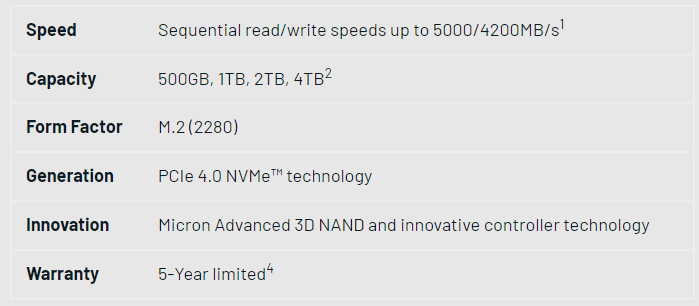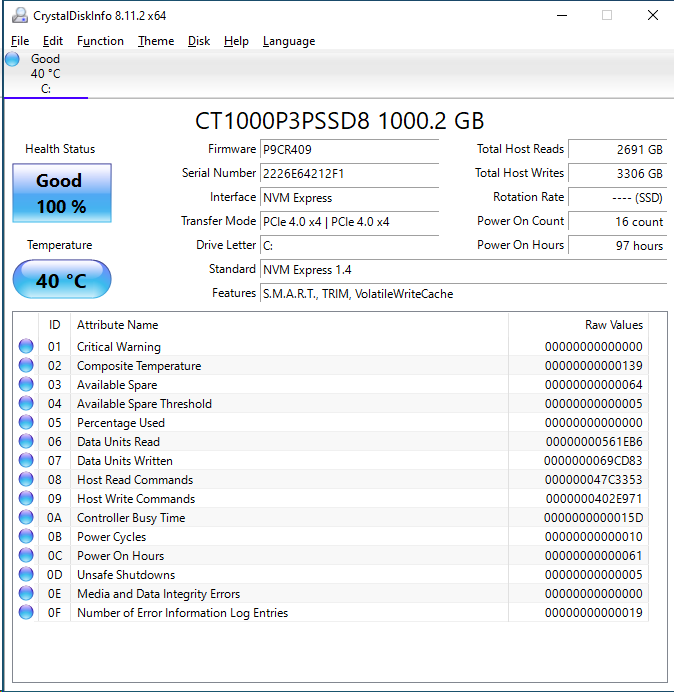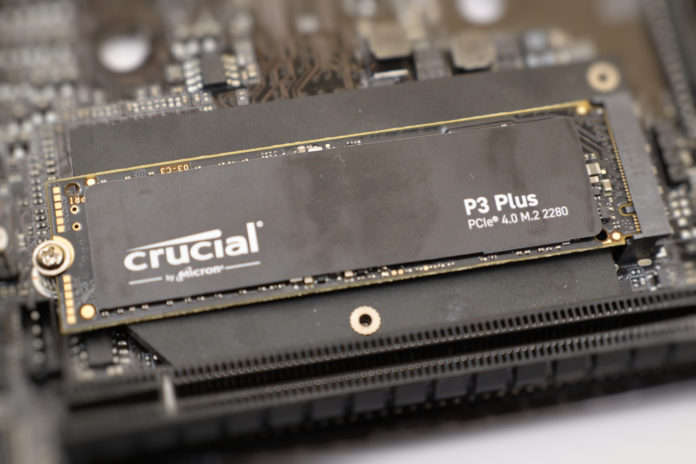Everybody forgets things occasionally! Back in September, Patrick sent me a bunch of drives to benchmark and review. Between the SSD buyers guide and some other content I was working on at the time, I managed to forget to review one of the drives I was sent. These recently became a topic because the pricing has been very low on Amazon (Affiliate Link) often at prices less than mid-range PCIe Gen3 SSDs. As a result, today we are looking at the Crucial P3 Plus 1TB SSD. The Crucial P3 Plus is Crucial’s entry-level PCIe 4.0 SSD, and exists between the base model P3 (which I also received but forgot to review!) and the P5 Plus. Patrick ended up acquiring a small collection of P3 Plus drives for the Asustor Flashstor 6 FS6706T NAS, so we thought it would be good to dust off my old benchmarks and post a review.
Crucial P3 Plus 1TB NVMe SSD
The Crucial P3 Plus 1TB comes in a single-sided M.2 2280 (80mm) form factor.

The Crucial P3 Plus uses a Phison E21T controller, which is paired with their 176-layer QLC flash. There is no DRAM cache on this drive, as one might expect given the more budget-oriented market positioning of this drive.

The back of the P3 Plus only contains regulatory markings and a label.
Crucial P3 Plus SSD Specs
The P3 Plus line of SSDs is available in sizes between 512GB and 4TB.


The Crucial P3 Plus we have today is the 1TB model. Sequential read speed is quoted at 5000 MB/s, with write speed at 3600 MB/s. As far as PCIe Gen 4 SSDs go, these are not particularly impressive specifications, but at least the read speed clearly exceeds what can be achieved by a Gen 3 drives.
Endurance is very poor 220 TBW. I consider the satisfactory line as 600 TBW for a 1TB drive, so the P3 Plus is quite a ways off from that. This is a QLC-based drive, which is likely what is contributing to the low-rated endurance. The warranty is the industry-standard 5 years, which is good to see.

CrystalDiskInfo can give us some basic information about the SSD and confirms we are operating at PCIe 4.0 x4 speeds using NVMe 1.4.
Test System Configuration
We are using the following configuration for this test:
- Motherboard: ASUS PRIME X570-P
- CPU: AMD Ryzen 9 5900X (12C/24T)
- RAM: 2x 16GB DDR4-3200 UDIMMs
Our testing uses the Crucial P3 Plus 1TB as the boot drive for the system, installed in the M.2_1 slot on the motherboard. The drive is filled to 85% capacity with data and then some is deleted, leaving around 60% used space on the volume.
Next, we are going to get into our performance testing.





When a test like ATTO 256MB QD4 32MB scores much better than expected, is the result repeatable? Is there a special pattern of use where the drive really performs that well which could be employed in a disk scheduling algorithm for an operating system?
Alternatively, if it’s a bug in the benchmark, why aren’t all devices affected. If they are, then why in different ways? It seems to me that some source-code auditable tests would be useful. Alternatively, could a ticket be opened with ATTO as to why their software exhibits what appears to be an bug on this test?
I suppose the result could also reflect a separate hardware issue with test rig itself.
Thanks for sharing all the results that were observed. In my opinion reporting the outliers is an important part of treating SSD testing as a science.
Crucial P3 Plus review
For the love of Pete, this reads like homework a student wrote the night before handing it in.
First of all, why do you ignore the use case of a drive before diving in to describe its performance?
This drive, like the Solidigm P41, is focused on the lowest cost per byte. In one of your final paragraphs you mention “The Crucial P3 Plus 1TB is $52 as of today. The Solidigm P41 Plus is $50. Every drive that I tested that was markedly better than either of those two drives is at least $15 more expensive”.
This means these two drives are *at least* 30% cheaper than any competition.
If you were reviewing a Prius you wouldn’t compare it’s performance to a Corvette or Charger yet in this review you state things like:
> This result is nothing short of horrible.
And
> The best thing to be said here is that it did not catastrophically fail in any particular test,
But you follow that immediately with:
> it is only at the bottom of the chart in Energy with much more respectable results in Product Development General Operations.
This is a drive, that based on price, you would *expect* to perform at the bottom in every category, but when it doesn’t you proclaim that it is a horrible device.
The use case matters and seeing benchmarks that are focused on that use case would be more beneficial. As an example, QLC is great for a backup target because those workloads are mostly WORM. There are very few overwrites or modifications to data so very little endurance will be used over the life of the drive.
For a workload like that we are less interested in how quickly it can be filled completely and more interested in how quickly it can inject a ZFS snapshot. (A thing we expect you’re doing based on your TrueNas articles)
Finally, in the Review Overview section you give a score of 6 out of 10 for Feature Set. But nowhere in the article do you cover the features that are implemented or those that are missing. Yet you have a quantitative score for this metric. What features are you scoring this (and all other drives) against?
I know this is the format you’ve used for SSD reviews for quite some time and you have a Moto of “if it’s not broke, don’t fix it”. But this is broke. Your testing methodology has fallen behind the rest of the industry the the execution of specific reviews is lacking.
John Stacker hits the nail on the head. But can you adapt?